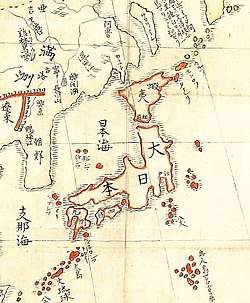Kyūan
Kyūan (久安), also romanized as Kyū-an, was a Japanese era name (年号,, nengō,, lit. "year name") after Ten'yō and before Ninpei. This period spanned the years from July 1145 through January 1151.[1] The reigning emperor was Konoe-tennō (近衛天皇).[2]
| History of Japan |
|---|
 |
Change of Era
Events
- 1145 (Kyūan 1, 8th month): The mother of former-Emperor Sutoku, Taiken-mon In, died.[3]
- 1146 (Kyūan 2, 2nd month), Emperor Konoe visited Emperor Toba-no-Hōō.[3]
- 1146 (Kyūan 2, 12th month), Konoe joined in a celebration honoring Sesshō Fujiwara no Tadamichi (the regent) on his 58th birthday.[5]
- 1148 (Kyūan 4, 6th month): The imperial palace was consumed by flames.[6]
- 1150 (Kyūan 6, 1st month): Konoe assumed the role of a mature adult; and he married Fujiwara-no Tokoku, who had been raised by sadaijin Fujiwara-no Yorinaga. Tokoku was the daughter of dainagon Taira-no Kiyomori. This bride became kōgū (first empress).[6]
- 1150 (Kyūan 6, 3rd month): Konoe married again, this time to a daughter raised by Sesshō Fujiwara-no Tadamichi. She was the daughter of Dainagon Fujiwara-no Koremichi. This bride became chūgyo (second empress). Konoe was so very much enamoured of this second wife that he neglected his first wife, which caused discord in the kugyō, especially between Tadamichi and Yorinaga.[6]
- 1150 (Kyūan 6, 12th month): Sesshō Minamoto-no Tadamichi, resigns his position and is named daijō daijin. In this same month, Minamoto-no Yoshikane became head of the Ashikaga clan in Shimotsuke Province.[6]
Notes
- Nussbaum, Louis-Frédéric. (2005). "Kyū-an" in Japan Encyclopedia, p. 587, p. 587, at Google Books; n.b., Louis-Frédéric is pseudonym of Louis-Frédéric Nussbaum, see Deutsche Nationalbibliothek Authority File Archived 2012-05-24 at Archive.today.
- Titsingh, Isaac. (1834). Annales des emepereurs du japon, pp. 186-188; Brown, Delmer et al. (1979). Gukanshō, pp. 324-326; Varley, H. Paul. (1980). Jinnō Shōtōki, p. 205.
- Titsingh, p. 186.
- Brown, pp. 325-326.
- Titsingh, p. 186; this event was important because, in each sexagenary cycle, the first and the fifty-eighth years were considered to be auspicious according to Chinese astrological principles.
- Titsingh, p. 187.
gollark: Horrendously bees configuration, about 300 dependencies, and external packages needed for everything.
gollark: G = { x: x is good }webpack∉G
gollark: Webpack is in fact bad i.e. the opposite of good.
gollark: No.
gollark: How do I "fix" this?
References
- Brown, Delmer M. and Ichirō Ishida, eds. (1979). Gukanshō: The Future and the Past. Berkeley: University of California Press. ISBN 978-0-520-03460-0; OCLC 251325323
- Nussbaum, Louis-Frédéric and Käthe Roth. (2005). Japan encyclopedia. Cambridge: Harvard University Press. ISBN 978-0-674-01753-5; OCLC 58053128
- Titsingh, Isaac. (1834). Nihon Odai Ichiran; ou, Annales des empereurs du Japon. Paris: Royal Asiatic Society, Oriental Translation Fund of Great Britain and Ireland. OCLC 5850691
- Varley, H. Paul. (1980). A Chronicle of Gods and Sovereigns: Jinnō Shōtōki of Kitabatake Chikafusa. New York: Columbia University Press. ISBN 9780231049405; OCLC 6042764
External links
- National Diet Library, "The Japanese Calendar" -- historical overview plus illustrative images from library's collection
| Preceded by Ten'yō |
Era or nengō Kyūan 1145–1151 |
Succeeded by Ninpei |
This article is issued from Wikipedia. The text is licensed under Creative Commons - Attribution - Sharealike. Additional terms may apply for the media files.